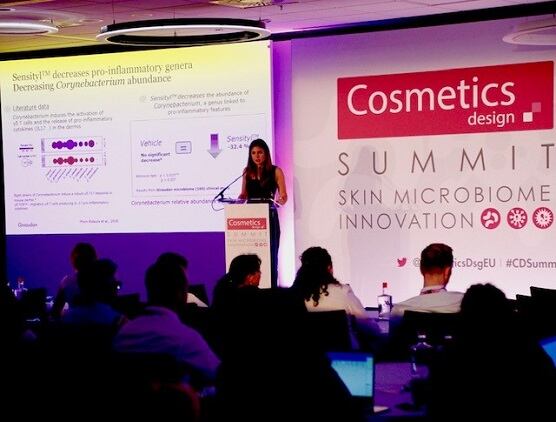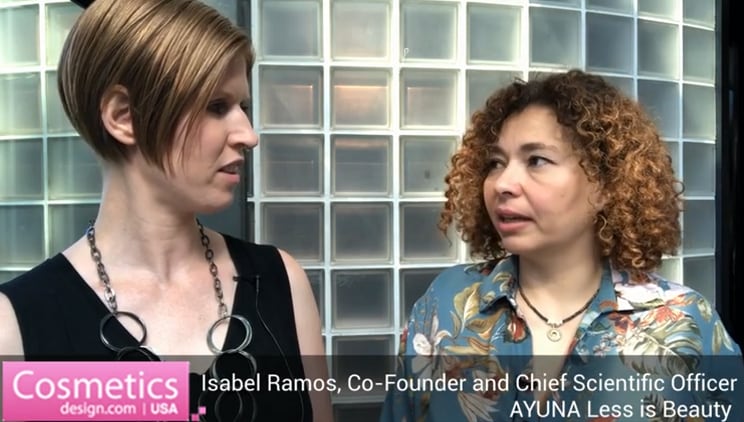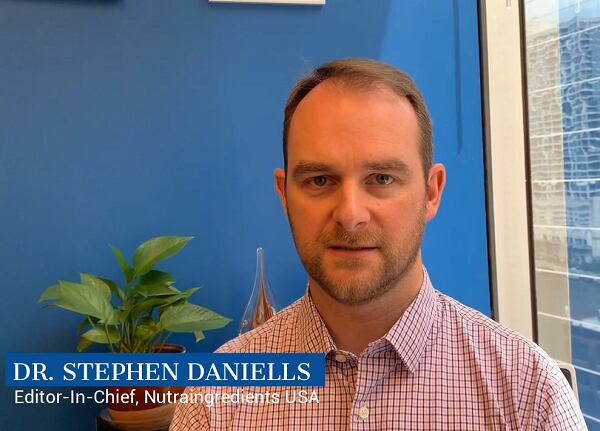Over the course of the two-day event, attendees engaged in conferences, networking sessions, roundtable lunches and a panel discussion to understand more about the role microbiome plays in skin health. Delegates explored how businesses can best leverage the cosmetics space to advance its offering and appeal to consumers.
We detail the key takeaways from each of our speakers, and what this means for the skin microbiome arena.
Probiotics in skin care
On Day 1, the keynote address was given by David Tyrell, Global Skincare Analyst for Beauty and Personal Care at Mintel, exploring the intersection between probiotics and skin care through the influential health and wellness message.
Opportunities available to microbe-derived fermentation products that include antioxidants, amino acids, peptides and lactic acid are largely associated with the benefits of skin protection, anti-ageing, moisturising and nourishing.
David comments that we will see the rise in probiotics in:
- Suncare as an emerging probiotic skincare category
- Reducing stress, anxiety and depression
- Beauty from within products
- Personalising beauty and grooming products
Probiotherapy and skin therapeutics
Exploring how scientific research has demonstrated that bacteria can positively impact our health, Ingmar Claes, Chief Scientific Officer at YUN explores the arrival of probiotherapy and how skin therapeutics are progressing the industry.
Live bacteria-encapsulation technology can provide an alternative to antibiotics. After the research findings associated with acne, Ingmar also explained how the industry is tipped to spur upcoming R&D investments anticipated to advance our understanding of identifying skin conditions.
3D Skin Models
Focusing on how the cosmetics industry can learn from 3D skin models to reveal the value of a diversity in skin microbiota, Dr Valerie Cenizo, Skin Biology Manager, L’Occitane Group explained how the skin microbiota is our first line of defense.
Research findings from clinical studies demonstrate how the microbiota and skin health are connected. L’Occitane identified that strain diversity has greater stability and is less invasive than single strains.
Microbiota-colonised 3D skin models can be used to imitate the skin to provide an ideal environment to test strains to further our understanding of skin microbiome using technological solutions.
The Impact of Urbanisation
Dr Chris Callewart, postdoctoral research fellow at the centre for microbial ecology and technology at Ghent University sought to understand the impact that the wider environment can have on the skin’s microbiome.
Through his research, Chris identified strong decreases of skin bacterial diversity, bacterial composition changes and alterations in the human skin bacteriome as a result of urbanisation. The human skin microbiome becomes more anaerobic, pathogenic and stress-tolerant.
Genes and personalisation
Dr Oliver Worsley, the co-founder of Sequential highlighted the relationship between genomic tools and skin personalisation. Research has focused on advancing skin microbiome applications through gathering and interpreting insights from gut microbes, understanding the connection between genetics and the microbiome, and the advent of genomic tools to provide personalised solutions.
Active ingredient selection
Active ingredient innovation is high on brands’ agenda, demonstrated through Givaudan’s exploration of healthy skin, healthy mind. Catherine Zanchetta, NGS Senior Specialist, at Givaudan Active Beauty discussed how the skin’s microbiome can spur the development of active ingredients and product development through core marketing messages such as the power of sensitive skin as a good-mood influencer.
The Art of Storytelling and Tech
Drawing inspiration from the Asia-based skin microbiome market, Nicole Fall, the Founder of Asian Consumer Intelligence said that the skin microbiome segment is currently in the “nascent” stage, bringing with it lots of opportunities.
Using artificial intelligence (AI) assisted research, we can understand consumer preferences and the zeitgeist influencing the skin microbiome trend. We can do this by exploring the commercial innovation already present in the market to spur future opportunities.
Emphasising the power of the brand story including values and provenance, Nicole encourages brands to utilise powerful marketing messages to communicate the impact their products can have on consumers’ skin microbiome.
Tom Morgan from Lumina Intelligence supports the importance of strategising and adopting clear and substantive marketing messages. Through understanding how consumers’ curiosity is impacting their research and engagement in the skin microbiome space, connection and communication with consumers is key.
Packaging design
Florence Roullet, Beauty formulations and Materials Director at Aprar tackled the packaging challenges of microbiome by exploring the popularity of preservative and microbiome-friendly innovative cosmetics packaging.
Discussing the evidence of extended in use life and product security, the industry focus is now on supporting robust and defensible product claims along with redefining finished products to transform them from formulation only to formulation-plus packaging.
Microbiome Restoration
Discussing the relationship between cleanliness and health, Jasmina Aganovic, President of Mother Dirt highlighted the importance of restoring the skin’s microbiome to help the personal care industry successfully engage with consumers.
Discussing the brand’s three core lessons along its journey from launch to established name, Jasmina highlighted the importance of understanding your strain, constantly researching and asking questions, and continuing to learn lessons while exploring digital native and physical retail landscapes.
The Third Wave of Cosmetics
Kit Waller Russell, co-founder and R&D director of JooMo delved into third wave cosmetics and how this is harnessing the power of the skin’s microbiome. The skin allergy entrepreneur discussed the prevalence of brands that are marketing their products as ‘natural’ when in fact they contain a number of synthetic ingredients — emphasising the impact this has on the skin allergy epidemic.
Regulatory Landscape
Patrick Goney, Safety Assessor at S&C Consultancy, discussed the strategy required by brands to balance the skin microbiota-based cosmetics with the current EU landscape.
The emphasis continues to be on the importance of providing proof and evidence to support claims labelling rather than making unsubstantiated assumptions to enable brands to compliantly build their position in the cosmetics marketplace.
Science and Stories
Discussing the relationship between storytelling and science, Michele Marchni, Consumer and Market Insights Manager of Personal Care, DSM, and Dr Mathias Gempeler, Global Head of Science and Promotion of Skin Care at DSM delved into our current understanding of the contribution of the skin microbiome towards our health. They also explained how, through scientific discovery and dedicated resources such as The Secret Life of Skin by DSM, we can learn more about the skin microbiome.
Look out for our in-depth spotlight content, articles and video interviews from our first ever Cosmetics Design Summit, plus information on next year’s event in coming weeks.



